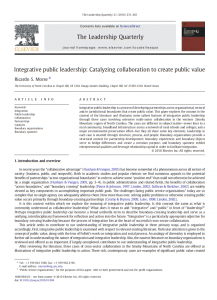
Integrative public leadership is a process of developing partnerships across organizational, sectoral and/or jurisdictional boundaries that create public value. This paper explores the concept in the context of the literature and illustrates some salient features of integrative public leadership through three cases involving extensive multi-sector collaboration in the western (Smoky Mountain) region of North Carolina. The cases are different in subject matter—sewer lines to a rural community, broadband infrastructure across a network of rural schools and colleges, and a major environmental preservation effort—but they all share some key elements. Leadership in each case is enacted through structure, process, and people. Boundary organizations provide a structural context for partnership development; boundary experiences and boundary objects serve to bridge differences and create a common purpose; and boundary spanners exhibit entrepreneurial qualities and leverage relationship capital in order to facilitate integration.
Cite as:
Ricardo S. Morse, Integrative public leadership: Catalyzing collaboration to create public value,
The Leadership Quarterly, Volume 21, Issue 2, 2010, Pages 231-245, ISSN 1048-9843, https://doi.org/10.1016/j.leaqua.2010.01.004. (http://www.sciencedirect.com/science/article/pii/S1048984310000238)
Download file
Public Leadership

